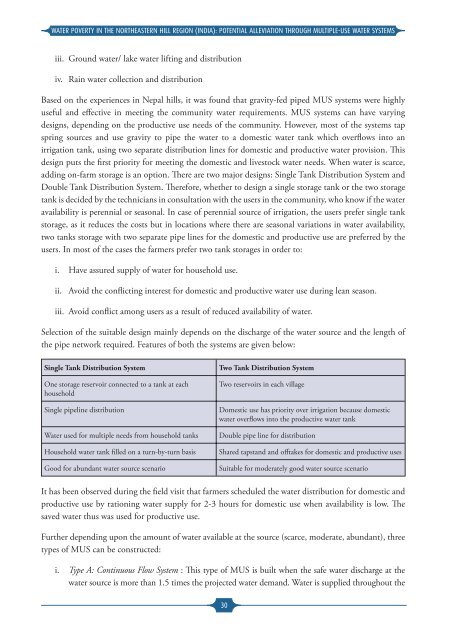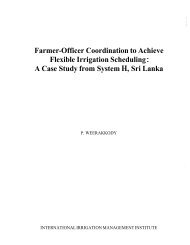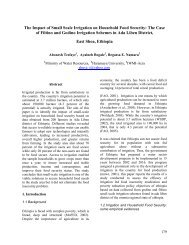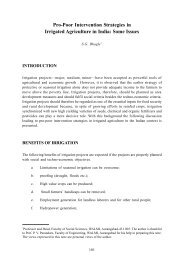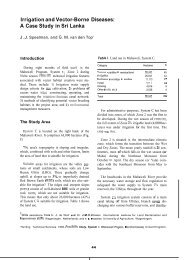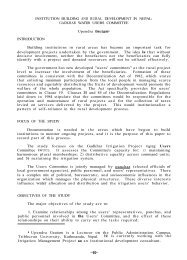WATER POVERTY IN THE NORTHEASTERN HILL REGION (INDIA)
WATER POVERTY IN THE NORTHEASTERN HILL REGION (INDIA)
WATER POVERTY IN THE NORTHEASTERN HILL REGION (INDIA)
You also want an ePaper? Increase the reach of your titles
YUMPU automatically turns print PDFs into web optimized ePapers that Google loves.
<strong>WATER</strong> <strong>POVERTY</strong> <strong>IN</strong> <strong>THE</strong> NOR<strong>THE</strong>ASTERN <strong>HILL</strong> <strong>REGION</strong> (<strong>IN</strong>DIA): POTENTIAL ALLEVIATION THROUGH MULTIPLE-USE <strong>WATER</strong> SYSTEMSiii.iv.Ground water/ lake water lifting and distributionRain water collection and distributionBased on the experiences in Nepal hills, it was found that gravity-fed piped MUS systems were highlyuseful and effective in meeting the community water requirements. MUS systems can have varyingdesigns, depending on the productive use needs of the community. However, most of the systems tapspring sources and use gravity to pipe the water to a domestic water tank which overflows into anirrigation tank, using two separate distribution lines for domestic and productive water provision. Thisdesign puts the first priority for meeting the domestic and livestock water needs. When water is scarce,adding on-farm storage is an option. There are two major designs: Single Tank Distribution System andDouble Tank Distribution System. Therefore, whether to design a single storage tank or the two storagetank is decided by the technicians in consultation with the users in the community, who know if the wateravailability is perennial or seasonal. In case of perennial source of irrigation, the users prefer single tankstorage, as it reduces the costs but in locations where there are seasonal variations in water availability,two tanks storage with two separate pipe lines for the domestic and productive use are preferred by theusers. In most of the cases the farmers prefer two tank storages in order to:i.ii.iii.Have assured supply of water for household use.Avoid the conflicting interest for domestic and productive water use during lean season.Avoid conflict among users as a result of reduced availability of water.Selection of the suitable design mainly depends on the discharge of the water source and the length ofthe pipe network required. Features of both the systems are given below:Single Tank Distribution SystemOne storage reservoir connected to a tank at eachhouseholdSingle pipeline distributionWater used for multiple needs from household tanksHousehold water tank filled on a turn-by-turn basisGood for abundant water source scenarioTwo Tank Distribution SystemTwo reservoirs in each villageDomestic use has priority over irrigation because domesticwater overflows into the productive water tankDouble pipe line for distributionShared tapstand and offtakes for domestic and productive usesSuitable for moderately good water source scenarioIt has been observed during the field visit that farmers scheduled the water distribution for domestic andproductive use by rationing water supply for 2-3 hours for domestic use when availability is low. Thesaved water thus was used for productive use.Further depending upon the amount of water available at the source (scarce, moderate, abundant), threetypes of MUS can be constructed:i. Type A: Continuous Flow System : This type of MUS is built when the safe water discharge at thewater source is more than 1.5 times the projected water demand. Water is supplied throughout the30


